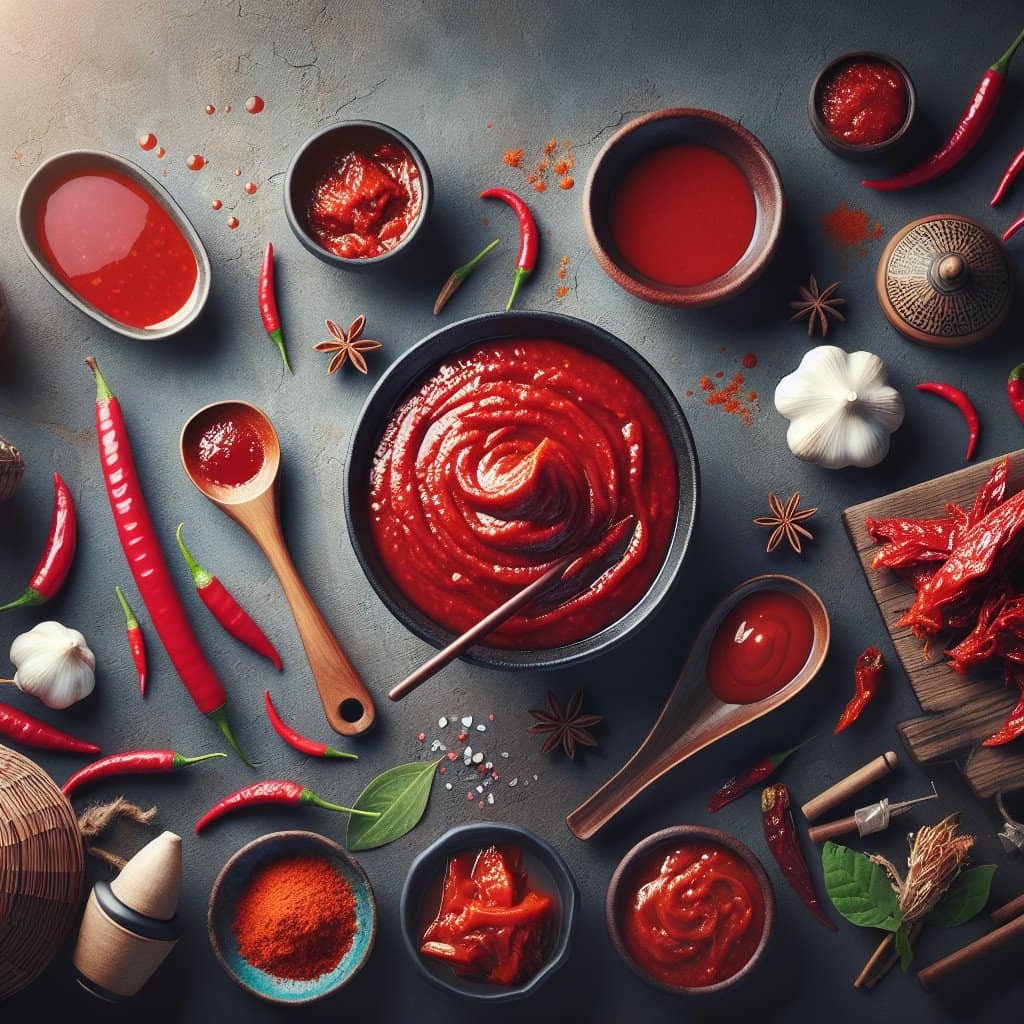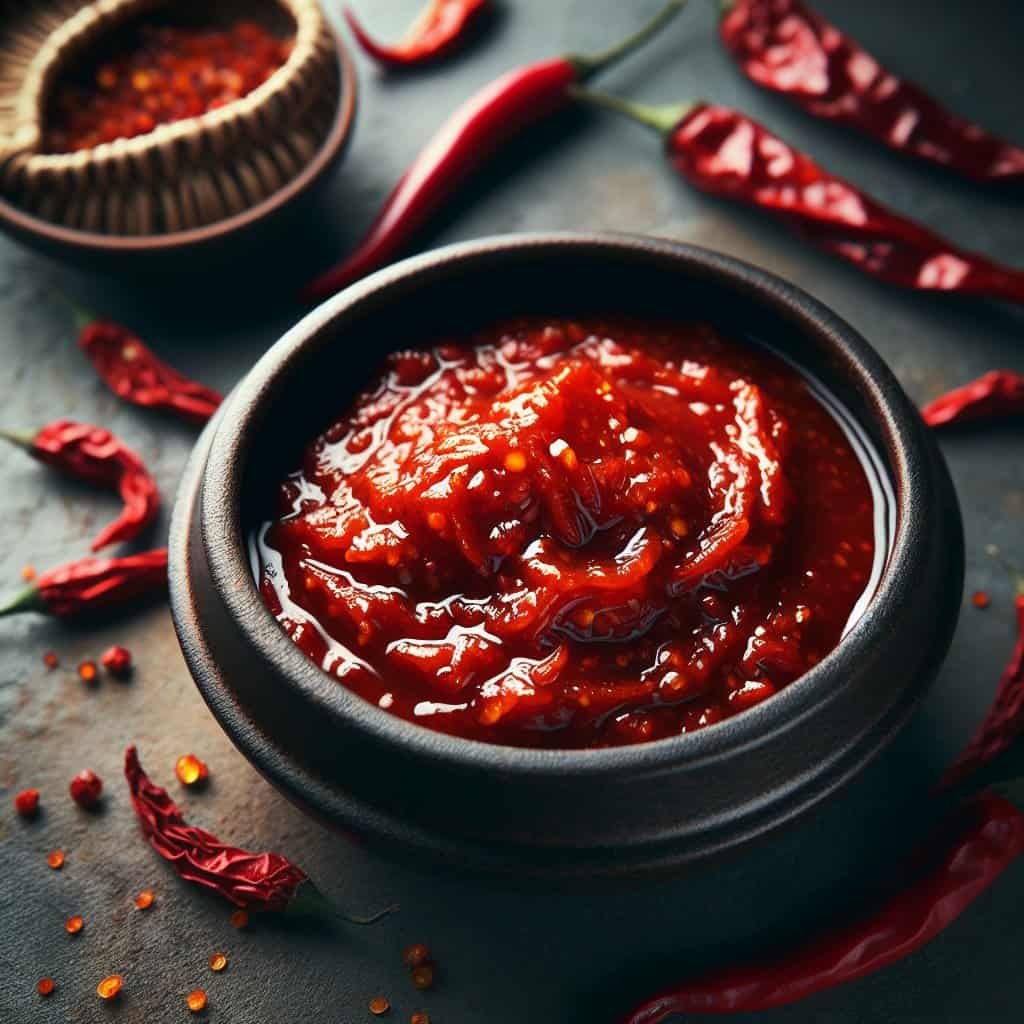Have you ever wondered about the secret behind the mouthwatering flavors of Korean cuisine? Look no further than gochujang – a vibrant and spicy chili paste that holds a profound significance in Korean cooking. With its rich umami flavor and complex blend of heat, sweetness, and savory notes, gochujang adds depth and character to dishes, making it an essential ingredient in Korean culinary traditions. Whether it’s used as a marinade, a dipping sauce, or a base for soups and stews, gochujang brings that distinctive taste that keeps you coming back for more. Let’s uncover the fascinating history and versatility of gochujang, and explore how it has become an integral part of Korean culture.

The Origins of Gochujang
Gochujang, a popular Korean fermented chili paste, has a rich and fascinating history. Its origins can be traced back to ancient times, where it was developed as a way to preserve and enhance the flavors of food. Historical records suggest that gochujang was first made during the Goryeo Dynasty (918-1392) in Korea. However, the exact date of its inception remains unknown.
Historical background
Gochujang gained popularity during the Joseon Dynasty (1392-1897) and became an essential part of Korean cuisine. It was traditionally made by fermenting chili peppers, glutinous rice, soybeans, and salt in earthenware pots called jangdok. The fermentation process could take months, allowing the flavors to develop and intensify.
Ingredients and preparation
The main ingredients of gochujang are gochugaru (red chili pepper flakes), meju (fermented soybean), glutinous rice, and salt. Traditionally, these ingredients were mixed together and left to ferment in the jangdok. The natural enzymes present in the soybeans and rice would break down the carbohydrates and proteins, creating a complex and savory flavor profile.
Key Characteristics of Gochujang
Gochujang possesses distinct characteristics that set it apart from other condiments. Its appearance, texture, flavor profile, and spice level contribute to its unique identity.
Appearance and texture
Gochujang has a thick and sticky consistency, similar to that of peanut butter. It ranges in color from deep red to brown, depending on the ingredients used and the fermentation period. The paste is smooth but may contain small particles due to the chili flakes.
Flavor profile
The flavor of gochujang is a harmonious blend of sweet, savory, and spicy notes. The natural sweetness from the rice and soybeans is balanced by the tanginess and umami flavors produced during fermentation. The chili peppers add a pleasant level of heat, while the complexity of flavors lingers on the taste buds.
Spice level
Despite the chili peppers’ presence, gochujang is not overwhelmingly spicy. It offers a moderate level of heat that enhances the overall flavor without overpowering the taste buds. However, different brands and varieties may offer varying levels of spiciness to cater to different preferences.
Gochujang as a Staple Ingredient
Gochujang’s versatility in Korean cuisine has propelled it to become a staple ingredient in countless dishes. Whether used as a marinade, seasoning, or base for sauces, its unique flavor profile adds depth and complexity to a wide range of recipes.
Versatility in Korean Cuisine
Gochujang is an essential component of traditional Korean cuisine and is used in various dishes. It is commonly found in stews, stir-fries, and dipping sauces. Additionally, it serves as a marinade for meats and a seasoning for rice and noodles. Its ability to enhance both the taste and appearance of dishes makes it an indispensable ingredient in Korean cooking.
Common uses in traditional dishes
Several iconic Korean dishes heavily rely on gochujang for their distinctive flavors. Bibimbap, a popular mixed rice dish, is typically served with a dollop of gochujang on top. Kimchi, the beloved Korean fermented vegetable side dish, often incorporates gochujang into its preparation. Other notable dishes include Tteokbokki (spicy rice cakes) and Jjigae (Korean stew).
Modern applications in fusion cuisine
As Korean culture extends its influence globally, gochujang has found its way into fusion cuisine. Chefs worldwide have embraced its unique flavors, using it to add a Korean twist to various international dishes. Gochujang-infused burgers, tacos, and even cocktails are now common in many trendy restaurants, showcasing the versatility and adaptability of this beloved ingredient.
Gochujang’s Nutritional Value
Apart from its remarkable taste, gochujang also offers notable nutritional value. Packed with essential nutrients, it brings both flavor and health benefits to the table.
Main nutrients
Gochujang is a rich source of vitamins and minerals, including vitamin C, vitamin K, iron, and potassium. The fermented soybeans in gochujang provide an excellent source of protein and dietary fiber. The chili peppers also contain capsaicin, a compound known for its potential health benefits.
Potential health benefits
Consuming gochujang in moderation can contribute to various aspects of health. The capsaicin in gochujang may aid in digestion, boost metabolism, and promote cardiovascular health. The fermentation process also enhances the bioavailability of nutrients, making them more easily absorbed by the body.

Cultural Significance of Gochujang
Gochujang holds deep cultural significance in Korea, serving as a symbol of Korean identity and playing a prominent role in celebrations and rituals.
Symbol of Korean identity
Gochujang represents the rich culinary heritage and cultural identity of Korea. It embodies the spice and complexity of Korean cuisine, and its presence in traditional dishes is a testament to the country’s culinary traditions.
Celebrations and rituals
Gochujang is often used in traditional Korean rituals and celebrations. During ancestral memorial services, gochujang is offered as a condiment to pay respect to the deceased. It is also a common ingredient used in celebratory dishes during festivals and holidays, symbolizing good fortune and prosperity.
Gochujang Production Process
The production process of gochujang involves traditional fermentation methods, but modern manufacturing techniques have also been adopted to meet the growing demand.
Traditional fermentation
In the traditional production of gochujang, the key ingredients are mixed together and stored in jangdok for fermentation. The natural microbial activity breaks down the starches and proteins, resulting in the complex flavors and aromas characteristic of gochujang. The length of fermentation can vary from several months to over a year, allowing the flavors to develop fully.
Modern manufacturing methods
To meet increased production demands, modern manufacturers use shorter fermentation periods and commercial production facilities. Large-scale stainless steel tanks are often used for fermentation, ensuring consistency in flavor and quality. However, some argue that the traditional fermentation process in earthenware pots yields a more authentic and nuanced gochujang.
Artisanal gochujang vs. commercial brands
Artisanal gochujang, crafted through traditional methods, often boasts more complex flavors and textures. The careful fermentation process and the use of high-quality ingredients contribute to its superior taste. Commercial brands, although more widely available, may have variations in flavor and quality due to the large-scale production methods employed.

Varieties and Regional Differences
Gochujang varies in taste and composition across different regions in Korea, offering unique experiences for culinary exploration.
Traditional regional types
Each region in Korea has its own style and variation of gochujang. The famous fermented chili pastes from Jeolla Province and Gyeonggi Province, for example, differ in terms of sweetness and spiciness. Some regions even infuse gochujang with local ingredients such as seafood or fruits, further diversifying the flavor profiles.
Contemporary variations
In recent years, contemporary variations of gochujang have emerged. Some manufacturers produce gochujang with lower spice levels to cater to milder palates, while others offer organic or gluten-free options. These variations ensure that gochujang can be enjoyed by a wider range of individuals and accommodate various dietary preferences.
Other Ingredients in Gochujang
Besides its core ingredients, gochujang may contain additional flavorings and sweeteners, contributing to its diverse taste palette.
Sweeteners
Traditionally, gochujang derives its sweetness from the fermentation process. However, some modern varieties may include the addition of sugar or honey to enhance the sweetness. These sweeteners balance out the spiciness and add complexity to the overall flavor.
Additional spices and flavorings
To add depth to the flavor profile, gochujang may incorporate various spices and flavorings. Garlic, ginger, sesame oil, and soy sauce are commonly used to enhance the overall taste. These additions complement the chili pepper flavor and contribute to the unique character of each gochujang variety.

Global Popularity and Culinary Influence
In recent years, Korean cuisine, with gochujang as a prominent feature, has gained immense popularity worldwide. The rise of Korean food culture has influenced both home cooking and professional kitchens, sparking a global culinary phenomenon.
Rise of Korean cuisine worldwide
The Korean Wave, or “Hallyu,” has propelled Korean culture, including its cuisine, onto the global stage. K-dramas, K-pop music, and Korean beauty products have helped popularize Korean food, including dishes featuring gochujang. The unique flavors, bold colors, and diverse range of Korean cuisine have attracted food enthusiasts from all around the world.
Incorporation in international recipes
Gochujang’s distinctive taste has found its way into international recipes, adding a novel twist to various global dishes. Chefs and home cooks alike have embraced gochujang, using it as a flavor enhancer or condiment in everything from tacos to pasta sauces. Its umami-packed profile and mild heat make gochujang a versatile ingredient that can elevate a wide range of culinary creations.
Gochujang in the Modern Food Industry
The global demand for gochujang has led to its commercial availability, with various brands and packaging trends catering to different markets.
Commercial availability
Gochujang is now readily available in grocery stores and online markets worldwide. Many well-known Korean food brands produce and export gochujang to meet the growing demand for Korean cuisine. Its popularity has also spurred the creation of gochujang-flavored snacks, seasoning blends, and ready-to-use sauces.
Marketing and packaging trends
To appeal to a wider audience, gochujang manufacturers have adopted innovative marketing strategies and packaging designs. Some brands offer convenient squeeze bottles, making it easier to measure and control the amount of gochujang used. The appealing branding and modern packaging designs have made gochujang more accessible and enticing to consumers around the globe.
In conclusion, gochujang holds immense significance in Korean cooking, both for its cultural importance and culinary versatility. From its ancient origins and traditional fermentation methods to its global popularity and contemporary variations, gochujang continues to captivate taste buds and inspire creativity in kitchens worldwide. As you explore the world of Korean cuisine, don’t forget to embrace the warmth, complexity, and unmistakable flavor of gochujang.

